Instrument Description
The Four Star infrared camera is a 1-2.5 micron near infrared camera for the
Magellan Baade Telescope. The instrument utilizes Four Rockwell HAWAII-2RG
imaging arrays in a close-packed arrangement to achieve a 4096 X 4096
equivalent pixel imaging area. The projected field size on
the sky is 10.9' X 10.9'. Four Star is a facility instrument for the Magellan
Consortium and is being built by Carnegie Observatories in Pasadena.
Funding for FourStar has been provided by the National Science Foundation and
the Carnegie Observatories.
Optical Design
Four Star will reside on the Magellan Nasmyth platform and utilize the F11 telescope secondary. A refractive optical system was chosen with all elements except the front window/lens being cooled to cryogenic temperatures and in a vacuum.
The Four Star optics were designed by Carnegie Staff member Stephen Schectman who also provided a similar refractive design for the PANIC IR camera. This optical design may be classified as a seven element design with three groups. The first group is a pair of field lenses which serve as a type of collimator to reconverge the beam. This group consists of two 16" diameter fused silica field lenses (L1, L2) which form an exit pupil just in front of element L3, reducing the beam waist and providing a useful location for a cold pupil stop. Element L1 also serves as a vacuum window. A cold and continuously adjustable cold stop is placed at the exit pupil. This cold stop blocks most stray thermal radiation from striking the detector. Elements L3, L4, L5, and L6 form the second group which we refer to as the Camera Module. The Camera Module essentially reconverges the telescope beam to F3.6 at the focal plane. Just before the focal plane the third group, consisting of a field flattener and filter performs additional aberration correction, field flattening, and filtering. There are three field flattener lenses, one for each IR filter, and the filter thicknesses are adjusted to match a given field flattener. This allows optimal aberration correction and optimal coating effectiveness in a part of the optical train where this is critical (near the focal plane). The disadvantage of this approach is that additional expense and care are required to carefully match filter and flattener characteristics. The final plate scale delivered by the F3.6 beam is 0.16"/pixel accommodating a total field of 10.9' X 10.9'.
The Four Star lenses are all spherical except for L3 which is a CaF2 element
with an aspherical surface front surface. The instrument will initially be deployed with three field
flattener lenses covering
the J,H, and Ks bands.
The optomechanical design can accommodate four field flatteners if
desired. There are two filter wheels, accommodating ten filters total. As
initially deployed FourStar will have broadband J,H, Ks filters and four
filters that subdivide the H band (HA-HD) for Methane and Water band for
studies of Brown Dwarf and cool star atmospheres.
Mechanical Design
The Four Star Dewar
is designed to provide a bi-modal cryogenic temperature environment whereby
the bulk of the optics are cooled to about 200 K-deg whereas the imaging arrays
and its environs are cooled to liquid nitrogen temperature
(77 K-deg). We have utilized this dual temperature approach before on the
PANIC IR camera and the WIRC IR camera at Baade and the duPont 100-inch, respectively,
with good success. The
dual temperature regime is
advantageous since problems associated with thermal stress,
thermally induced changes in optical properties, and thermally induced
changes in glass optical properties are reduced to more manageable levels.
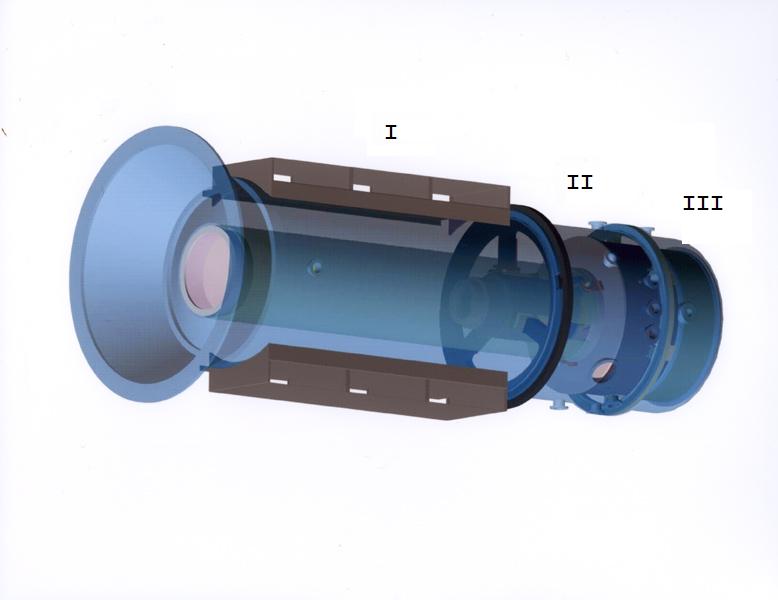
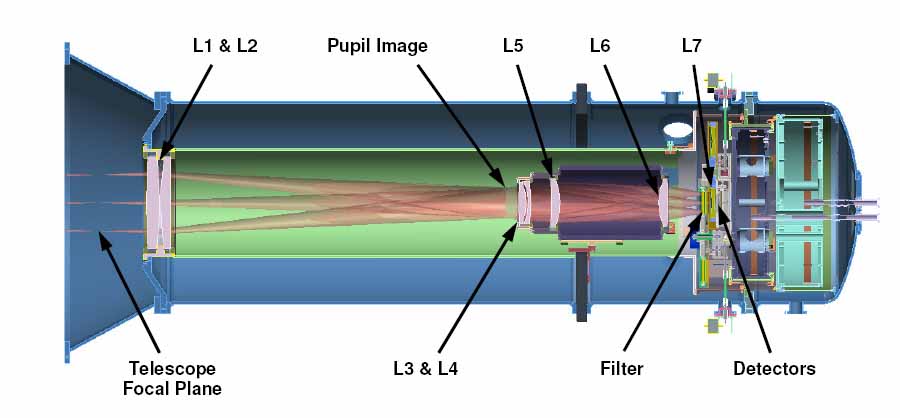
The Four Star Dewar consists of three main sections: I, II, and III. As seen in the solid model above (described from left to right) a conical section adapts Four Star to the Magellan Nasmyth rotating ring/guider assembly. Light expanding from the telescope focal plane enters the field lens pair (lens Group 1) and travels down a radiation shield/light baffle to the Camera Module (lens Group 2). The Camera Module lenses are supported in an Invar cell held by three flextures radiating outwards to an external ring, penetrating the radiation shield, and attaching to the vacuum vessel. The outer surface of the ring serves as a rolling surface for astatic support. The Camera Module lenses are assembled and aligned as a unit. Just to the right of the Camera module the radiation shield transitions to a mating shield in section II which is at liquid nitrogen temperature (LN2). The joining of these two shields is by adjustable thermal shunts tuned to balance the heat load on the section I shield and maintain it close to 200 K-deg.
Filter and
Flattener Wheels
Filter/Flattener Wheel Detail
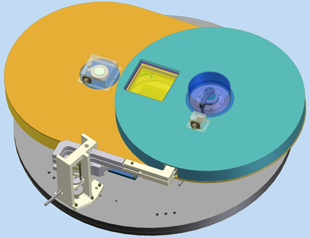
 Section II contains the detectors, field flattener wheel, filter wheel, and
internal ASIC cold PCB cards, all enclosed in a LN2 temperature shield. These
structures mount to a cold plate that is the front surface of an internal
LN2 tank designed to cool the array and these associated structures. Behind this tank is
a larger tank in Section III that holds
the LN2 reservoir for the radiation shields.
Section II contains the detectors, field flattener wheel, filter wheel, and
internal ASIC cold PCB cards, all enclosed in a LN2 temperature shield. These
structures mount to a cold plate that is the front surface of an internal
LN2 tank designed to cool the array and these associated structures. Behind this tank is
a larger tank in Section III that holds
the LN2 reservoir for the radiation shields.
The Dewar and its associated support components are designed for
ease of operation to help reduce burden of routine support and operations.
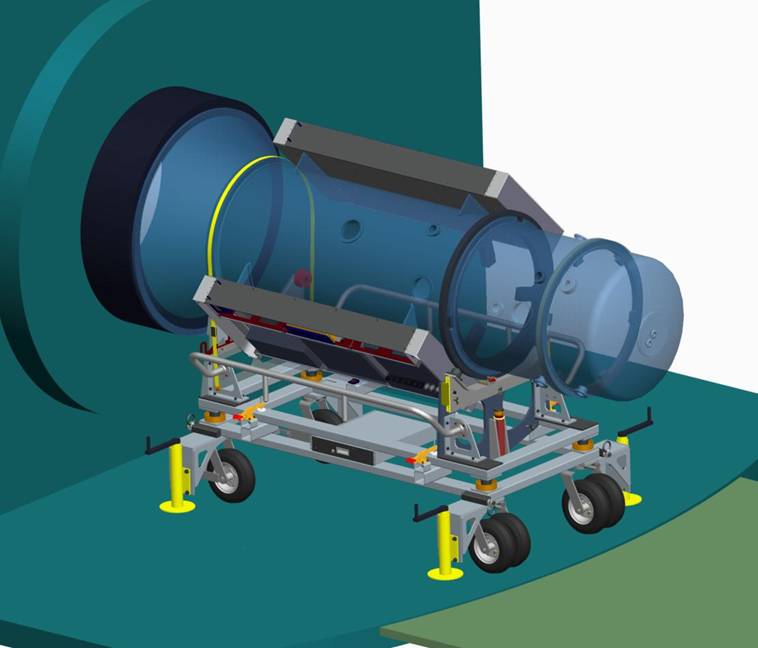 The larger LN2 tank which is under the largest heat load and will boil off its LN2 first before the small can. It is therefore imperative that this tank be keep well-filled at all times. To facilitate this, a
fill tube from this tank is co-linear with the
rotational axis of the instrument so that a fill "stinger" from an automated fill system can
remain permanently in place. Also, to minimize handling overhead, all electronic instruments supporting the dewar
will be attached to, and travel with, the instrument. There is a control computer that moves with Four Star (on its
handling cart) and camera is both fully usable and self contained, on or off the telescope. The Four Star handling cart
incorporates the astatic support roller mechanism to unload weight from the Nasmyth rotator bearing. Once assembled
in Chile, the cart will always remains with the dewar.
The larger LN2 tank which is under the largest heat load and will boil off its LN2 first before the small can. It is therefore imperative that this tank be keep well-filled at all times. To facilitate this, a
fill tube from this tank is co-linear with the
rotational axis of the instrument so that a fill "stinger" from an automated fill system can
remain permanently in place. Also, to minimize handling overhead, all electronic instruments supporting the dewar
will be attached to, and travel with, the instrument. There is a control computer that moves with Four Star (on its
handling cart) and camera is both fully usable and self contained, on or off the telescope. The Four Star handling cart
incorporates the astatic support roller mechanism to unload weight from the Nasmyth rotator bearing. Once assembled
in Chile, the cart will always remains with the dewar.
Four Star Electronics and Data System
In stark contrast to the proceeding generation of infrared cameras, the required external electronic support for Four Star is minimal. Rockwell has supplied application specific integrated circuits (ASIC's) which are deployed at liquid nitrogen temperature inside the cryogenic dewar. All array biasing, clocking, and analog-to-digital conversion are provided by the ASIC's. The only additional electronics to facilitate readout are small external boards fastened in blister boxes just outside section II of the dewar which hold field programmable gate arrays (FPGA's) that "glue" the ASIC logic interface to USB 2.0. Thus each array is a USB device, very analogous to a consumer digital camera. Remarkably even array power is derived through USB. The end user must supply only a computer with USB ports, Windows XP, and appropriate drivers and software.
Our data system is entirely IP based: every device that touches hardware has an IP address. All
communications links are using either 10, 100, or 1000 BaseT or BaseFX (fiber optics) depending upon the
required bandwidth and electrical isolation desired. Thus temperature monitors, temperature controllers, motor
controllers, the telescope interface, workstations, and the array readout computers are all IP devices. Among the many advantages

The camera electronics are mostly confined to two 3U high 19-inch racks symmetrically located on the diameter
of section I of the dewar. By keeping the electronics with the rotating dewar we avoid the problem
of implementing a cable wrap. The only connections from the dewar to the inertial reference frame are
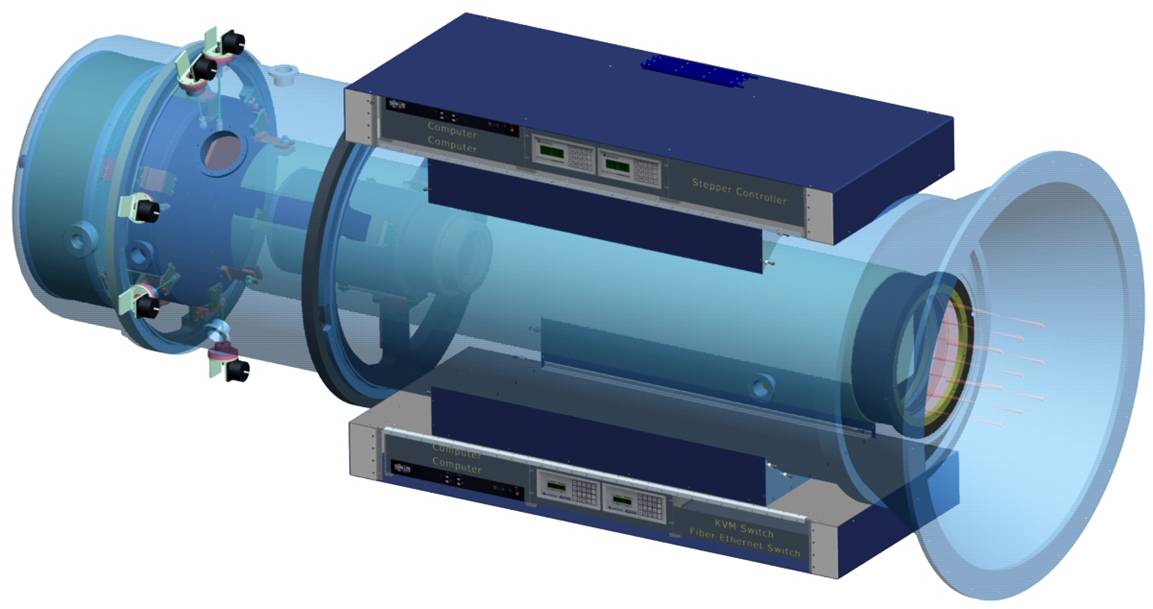 one fiber optic cable, one thin hose for water-glycol cooling, and AC power. These cables will all be routed
through an existing cable wrap used by the telescope guider. The electronic units in their racks
generate
one fiber optic cable, one thin hose for water-glycol cooling, and AC power. These cables will all be routed
through an existing cable wrap used by the telescope guider. The electronic units in their racks
generate
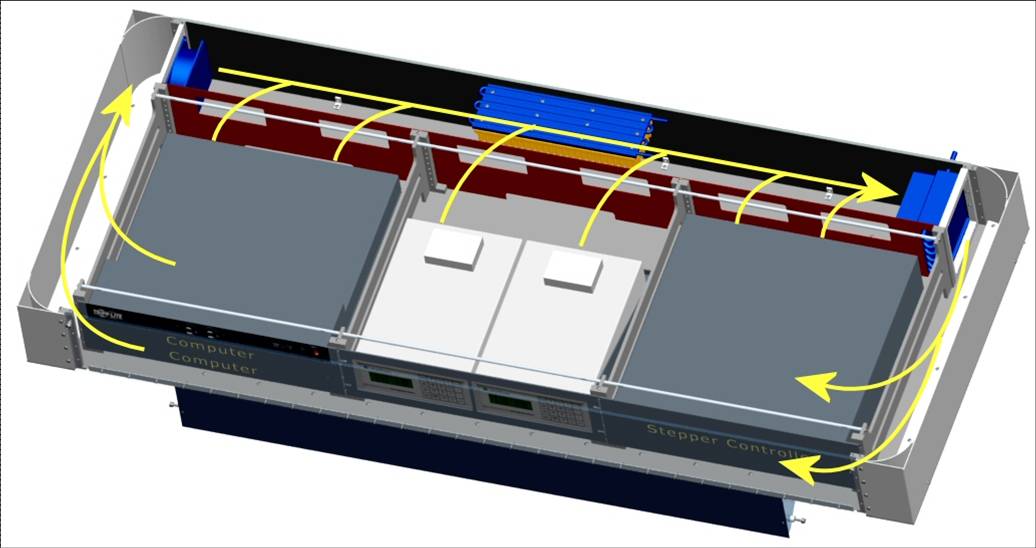 482 Watts of power most of which is removed by fans internally recirculating air past glycol heat exchangers.
482 Watts of power most of which is removed by fans internally recirculating air past glycol heat exchangers.
The computer system for Four Star consists of seven computers. There are four Array Servers on the dewar,
one dedicated to each HAWAII-2RG array. These are essentially autonomous controllers that accept requests
from clients to read the arrays, format the image data into sensible data frames with header
information, and transfer the image frames to end user work stations. All observer interaction will occur using
Mac OS-X based computers. The observer will nominally operate the camera with the Control Room Mac and reduce
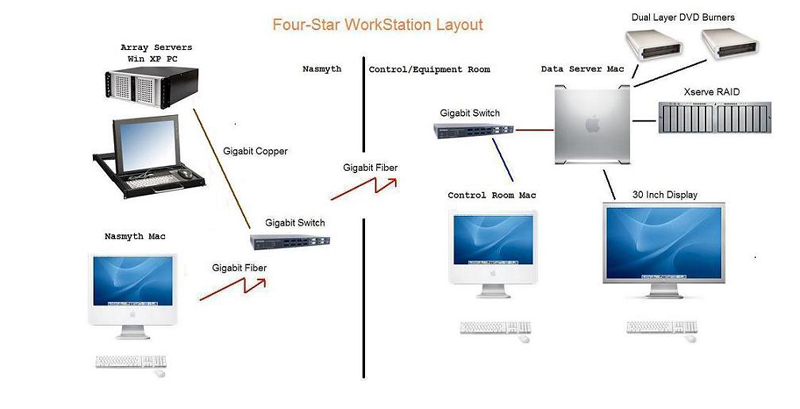
Each computer is generously equipped with disk space, memory, and screen real estate, but the Data Server Mac more so than the other two Mac's. This computer will be available for such computationally intensive tasks as running real time quick look reduction packages as well as concurrent pipeline operations. The Data Server Mac will be especially well-provided with disk space and mass storage capability. The data system software will be implemented with a Mac OS GUI (i.e. not X11). It is designed to be run from any Mac on the network Four Star network segment, and possibly as well, by Macs located outside the Four Star segment by implementing a Virtual Private Network.